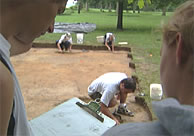 |
 |
|
Field school students
take notes on the excavations.
|
|
|

WRG member Randolphy Turner describes
the goals of the projects: Project
Goals
When members of the Virginia Company landed
at Jamestown in 1607 they stepped into a world of Algonquin communities
bound together within a powerful chiefdom polity centered on Werowocomoco.
Despite enturies of scholarship aimed at explaining events of the
Contact period, much remains to be learned regarding the cultural
perspective of the Powhatan participants. Documentary accounts offer
critical evidence of this period, though the English narratives
are tinged with biases. Understanding the Chesapeake Contact period
requires the study of Powhatan settlements in an effort to consider
Native culture history on its own terms.
Two overarching objectives have driven
the Werowocomoco Research Group. The first is to investigate a prominent
Native village site in order to develop a fuller understanding of
the Contact period in the Chesapeake. Secondly, we have designed
the research around a program of public outreach and close consultation
with Native communities. To date, we have assembled a research team
and developed partnerships with tribes descended from the Powhatans
in an effort to include Virginia Indian voices in the research.
We have completed a comprehensive shovel-test survey and conducted
a preliminary field season confirming the site's research potential.
Our field research indicates that the site was a remarkably large
and dispersed village circa 1607 containing well-preserved evidence
of Powhatan village life.
Future research at the site will consider
two broad themes:
1) a community-oriented perspective on
the development of the Powhatan chiefdom from A.D. 1300 - 1609 and,
2) a study of the material consequences
of the Chesapeake colonial encounter from the vantage of a Native
center.
Our investigations will focus on changes
in the settlement's spatial organization, exchange patterns, and
maize production during the periods immediately before and after
1607. Our intent is to contribute to an understanding of how social
power came to be concentrated within and exercised from Werowocomoco.
|



